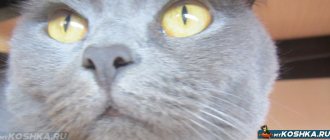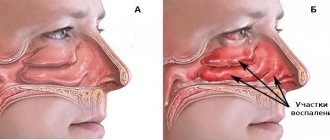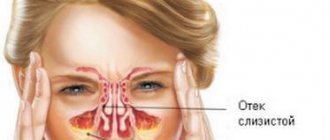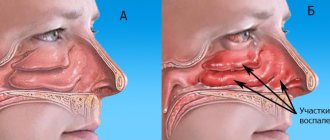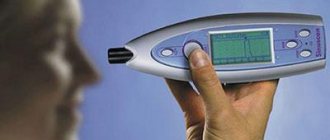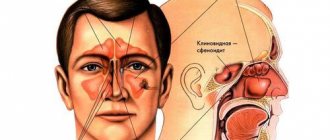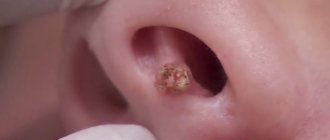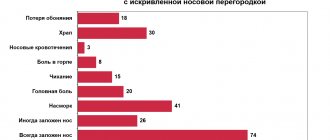Chronic rhinosinusitis in cats
Chronic rhinosinusitis in cats is a syndrome characterized by inflammation of the nasal passages and sinuses, resulting in constant or intermittent nasal discharge and sneezing.
The pathophysiology of chronic rhinotracheitis is not completely clear. Rhinosinusitis affects cats of any breed, age and gender. At the moment, chronic rhinosinusitis in cats does not have an exact cause. Diagnostic efforts should be aimed at excluding specific causes of nasal discharge and associated clinical signs.
Cats that have had respiratory viral infections in the past are at risk.
Rhinotracheitis and calicivirus are common causes of acute upper respiratory tract infection in kittens and adult cats.
The acute period of infection usually passes, but the rhinotracheitis virus does not leave the cat’s body, and it becomes a latent carrier. Similarly, cats can remain carriers of calicivirus for many years.
Latent infection can manifest itself, especially during times of stress. The role of active viral infection in the pathogenesis of rhinosinusitis has not been documented.
Viral infection can lead to cytolysis and subsequent damage to the protective mechanisms of the nasal mucosa. This, in turn, predisposes to the occurrence of secondary bacterial infection.
The nasal passages and sinuses are usually nonsterile and contain a wide range of microorganisms, including some types of streptococci, staphylococci, corynebacteria, pasteurella, klebsiella, enterobacter, Escherichia coli, and Pseudomonas aeruginosa. Bacterial infection in cases of chronic rhinosinusitis in cats is likely secondary rather than primary.
Rhinosinusitis in cats - symptoms
Symptoms are mainly persistent or chronic runny nose. The discharge can be unilateral, but more often bilateral and has a mucopurulent character. Sometimes the discharge is mixed with blood.
Other clinical signs include sneezing, wheezing, and discharge from the eyes. Less common are vomiting, coughing and anorexia.
Clinical examination, as a rule, does not reveal anything other than what concerns the nasal passages and sinuses. Nasal discharge may be visible, but not always as cats are usually very clean.
If there is deformation of the muzzle, complete obstruction of the air flow, or severe dental disease, then a different diagnosis should be considered.
Rhinosinusitis in cats is usually not painful, but it can cause discomfort.
Diagnosis of rhinosinusitis
To make a diagnosis of chronic rhinosinusitis in cats, it is necessary to exclude other causes of diseases of the nasal cavity and sinuses.
The differential diagnosis for cats with acute, short-duration symptoms is different from that for cats with chronic, persistent, or recurrent symptoms.
Differential diagnoses for cats with chronic signs include nasal neoplasia (most commonly lymphoma and carcinoma). Fungal rhinitis (usually cryptococcosis). Periodontitis, nasopharyngeal polyps and foreign bodies in the nasal cavity.
Differential diagnoses for an acute process include all those mentioned above for cats with a chronic course of the disease, as well as herpesvirus, calicivirus, chlamydia, and bordetellosis.
Routine tests, such as complete clinical and biochemical blood tests, complete clinical urine analysis, and serological tests are useful in determining general health status, but do not contribute to the diagnosis of this clinical syndrome.
X-rays and computed tomography may not be very informative. Sometimes there is a change in the normal shape of the turbinates, and an accumulation of secretions in the sinuses.
Bacteriological culture of swabs can determine the bacterial microflora, but does not prove the leading role of microbial infection.
During rhinoscopy, either no changes are detected, or mucus and hyperemia are observed in the affected nasal passages. Sometimes during rhinoscopy, destruction or curvature of the nasal turbinates is visualized.
A biopsy may reveal neutrophilic or lymphoplasmacytic inflammation. This is most useful for differential diagnosis, including neoplasms.
Rhinosinusitis in cats - treatment
Treatment does not lead to a complete recovery of the cat, but it helps relieve the symptoms of the disease.
Your doctor may prescribe maintenance therapy. For example, air humidification, inhalation of saline solutions, sometimes rinsing the nasal passages under sedation. In some cases, especially if a secondary infection is detected, antibiotics or anti-inflammatory drugs may be prescribed.
Source: https://laskavet.ru/therapy/rinosinusit-u-koshek/
Sinusitis in cats: symptoms and treatment
- Calicivirus
- Pneumonia
- Tuberculosis
- Mycoplasmosis and other parasitic infections
Sinusitis in cats is an inflammation of the mucous membrane in one or more paranasal sinuses.The animal experiences a decrease in appetite, lethargy, a depressed state, and possible snorting and sneezing. With frontal sinusitis, the cat sits with its eyes half-closed and its head down.
Treatment of sinusitis in cats.
If a cat has a stuffy nose, then most likely he has an inflammatory process of the nasal mucosa due to a cold. The cat could be in a draft or become hypothermic outside. As you know, untreated rhinitis and runny nose can cause complications in the form of sinusitis in cats, so let’s look at the symptoms and treatment.
Causes of sinusitis in cats
Some will say that sinusitis in cats is funny and too strange, but the reaction of the owner of a beloved pet who has fallen ill with this unpleasant disease will be completely different.
As in humans, maxillary sinusitis in cats is an inflammation of the sinus lining.
It usually occurs as a complication after infectious diseases, as well as allergies and caries; in rare cases, the cause is parasites that have entered the nasal cavity. The course of the disease can be either chronic or acute.
Sinusitis in cats is treated approximately according to this scheme:
- Instillation of maxidin (0.15%) or furatsilin (0.1%) into the nasal passages locally.
- If the cause of the disease is a virus, an alcohol tincture of propolis is used.
- If possible, UHF heating is carried out.
- It is also possible to treat an animal with homeopathy, for this you should also contact a homeopath.
- Calicivirus
- Pneumonia
- Tuberculosis
- Mycoplasmosis and other parasitic infections
- Nasal discharge, runny nose;
- Sneezing;
- Shortness of breath (difficulty breathing);
- wheezing (snoring) caused by difficulty breathing;
- Difficulty breathing - breathing through the mouth due to lack of air inhaled through the nose;
- Infectious diseases
Sinusitis in cats is an inflammation of the mucous membrane in one or more paranasal sinuses.
https://www..com/watch?v=ytpolicyandsafetyde
The animal experiences a decrease in appetite, lethargy, a depressed state, and possible snorting and sneezing. With frontal sinusitis, the cat sits with its eyes half-closed and its head down.
Treatment of sinusitis in cats.
Sinusitis in cats: symptoms and treatment
www.icatcare.org
Chronic (long-term) upper respiratory disease (also known as chronic runny nose) is a relatively rare problem in cats. Such diseases occur for many reasons.
The syndrome refers to a chronic condition that affects a cat's nose (nasal cavity) or nasopharynx (air passages directly behind the nose). Most often, the disease manifests itself in the form of chronic post-viral rhinitis (inflammation or infection in the nose).
A viral infection (such as that caused by feline herpesvirus (FHV) or feline calicivirus (FCV)) causes damage to the delicate mucous membrane inside the nose, and even the turbinate may be damaged.
Chronic upper respiratory disease in cats can develop for many other reasons, including facial deformities (as in the flat-faced extreme Persian cats), nasopharyngeal stenosis (when the nasopharynx narrows abnormally) and trauma.
The main signs of diseases are:
The veterinarian will be able to determine the nature of the disease by answering some questions:
- Are problems occurring on one or both sides of the nose?
- Is the discharge coming from one or both of your cat's nostrils?
- What does the discharge look like - clear, watery, mucous, purulent?
- Are there traces of blood in the discharge? Often, although not always, the presence of blood indicates more serious illnesses such as fungal infections or neoplasia. Are there any facial tumors or changes in the shape of the cat's face or nose? Often, although not always, this can be a sign of more serious illnesses such as fungal infections or neoplasia.
- Is there discharge from the eyes (tearfulness)?
- Are there any signs of ear disease? Sometimes you can partially see the inflammatory polyps.
- Are there any enlarged lymph nodes in the head and neck? If so, they may need to be examined.
- Are there any changes in your cat's appetite or weight? Cats with upper respiratory tract diseases often experience decreased appetite, but noticeable weight loss may indicate a more severe illness.
- Did the symptoms appear quickly or progress gradually?
- Are the signs of the disease gradually becoming more noticeable?
If you prepare answers to these questions before visiting your veterinarian, it will be easier for him to get an idea of the possible causes and methods of treating your cat.
Sometimes, a cat's medical history, clinical signs and test results give the doctor reason to suspect the presence of an underlying disease that is causing the cat's respiratory problems.
In this case, additional examinations are necessary.
In severe cases, when clinical symptoms worsen or when there are signs of other diseases, additional tests may also be required.
Exactly what tests and examinations are needed depends on the specific situation. Most often this is:
- Urine and blood tests. If necessary, the presence of feline leukemia virus and immunodeficiency is detected. A blood test may also help identify other infections (such as Cryptococcus).
- X-ray of the nose, throat, chest and possibly abdomen. X-rays are very useful in identifying changes in different organs. In some situations, it may be necessary to obtain better images using CT scanners or MRI scanners. Unfortunately, such procedures, although they provide clearer images of the internal structures of a cat's nose and nasopharynx, are not available everywhere.
- Endoscopy (rhinoscopy). While the anesthesia required for the x-ray is in effect, the doctor can examine the cat more closely, using a small endoscope inserted through the nose or mouth to examine the back of the nose. This method provides direct visualization of certain structures of the cat's nose.
- Biopsy. Often very valuable information is provided by biopsy of small tissue samples taken from the nose for histological examination by a pathologist and examination of cultures for microorganisms present. Collecting biopsy samples causes some bleeding, but usually very little.
It is important to keep in mind that many of these tests in the case of post-viral rhinitis can give ordinary, non-specific results, so the disease is often diagnosed by ruling out other possible causes.
Treatment depends on the underlying cause of the disease. Some can be eliminated, others can be kept under control (by relieving symptoms), some diseases may be incurable. An appropriate method is selected for treatment.
Some cats have their nasal passages periodically irrigated and cleared under anesthesia.
In some cases, the use of corticosteroids in the form of drops, tablets or injections has been beneficial - these drugs help relieve inflammation and sometimes even relieve idiopathic rhinitis (for example, lymphoplasmatic inflammation caused by an overreaction of the immune system).
For sick cats, good care, keeping the face clean, and clearing the nose and eyes of secretions is very important. Heating food to enhance its smell can help maintain your cat's appetite.
More details
Sinusitis (maxillary sinusitis) in cats is an inflammation of the mucous membrane of the maxillary sinus.
Most often, sinusitis occurs as a result of infection entering the maxillary cavity. This is possible with caries and colds. There is also allergic sinusitis.
The animal becomes lethargic, depressed, appetite decreases, body temperature rises by 0.5 - 1.0 degrees. Mucous or mucous-purulent unilateral discharge appears from the nose.
Sulfonamides or penicillin antibiotics (ampicillin, neopen, albipen LA, ampiox for kittens) are administered intramuscularly; UHF is indicated.
St. John's wort tincture is injected into the maxillary cavity to suppress the growth of microbes and as a means that accelerates the restoration of damaged tissue.
More details
If a cat has a stuffy nose, then most likely he has an inflammatory process of the nasal mucosa due to a cold. The cat could be in a draft or become hypothermic outside. As you know, untreated rhinitis and runny nose can cause complications in the form of sinusitis in cats, so let’s look at the symptoms and treatment.
As in humans, sinusitis in cats manifests itself with similar symptoms. The pathology is characterized by the following symptoms:
- cough;
- constant rubbing of the nose with paws;
- sneezing;
- weakness;
- drowsiness;
- loss of appetite;
- increased body temperature;
- mucous and purulent discharge from the sinuses;
- redness of the mucous membrane of the eyes.
The disease can be both acute and chronic.
Acute sinusitis is more common in children, and develops as a complication of acute or allergic rhinitis (runny nose), viral (influenza, ARVI) and infectious (measles, scarlet fever) diseases, immunity disorders, dental diseases (caries) and oral cavity (stomatitis, tonsillitis - tonsillitis). The cause of sinusitis can also be adenoids, which disrupt the process of nasal breathing and serve as a constant source of infection.
The chronic form of the disease, as a rule, is a consequence of acute inflammation if there are unfavorable conditions for the outflow of pathological secretions accumulated in the sinuses. The reason for this may be thickening of the nasal mucosa, curvature of the nasal septum, hypertrophy of the nasal turbinates.
Most often, sinusitis occurs in winter, when there is a natural decrease in immunity and seasonal hypovitaminosis.
The maxillary sinuses (paired) are one of the paranasal sinuses. There are also two frontal sinuses (above the eye sockets), two ethmoid sinuses (in the nasal cavity), and one sphenoid sinus (at the base of the skull). They are air cavities that lie around and inside the nasal cavity in the thickness of the bones of the skull.
Source: https://otfortlove.ru/diagnostika-lechenie-gaymorita-koshek/
Sinusitis in dogs symptoms
19.07.2018
Sinusitis (Higmoritis) is an inflammation of the mucous membrane of the maxillary sinus, accompanied by the accumulation of exudate, severe intoxication of the body, a large flow of pathological impulses to the cerebral cortex and often softening of the bone tissue in the area of the affected cavity.
When an ichorous mass accumulates in the cavity, the disease is called empyema.
According to their course, sinusitis in animals can be acute and chronic, according to the nature of the inflammatory process - serous, catarrhal and purulent.
Sinusitis occurs in horses and dogs, but is rare in other animals.
Etiology . The disease mainly occurs in animals as a result of infection entering the maxillary cavity, as follows: as a result of complications with rhinitis, laryngitis, pharyngitis, osteomyelitis, dental caries, frontal sinusitis, actinomycosis, washing, horse glanders, botryomycosis, malignant catarrhal fever, in pigs with atrophic rhinitis. Primary sinusitis in animals occurs with penetrating wounds of the maxillary cavity, fractures of the facial bones, and malignant tumors. The occurrence of rhinitis in animals is predisposed by: colds, deficiency of vitamins A and D in the animal’s diet.
Pathogenesis . During the process of inflammation in the maxillary cavity, mucopurulent or purulent exudate accumulates, part of which enters the middle nasal passage, part of the exudate undergoes decay, acquiring an ichorous odor. The resulting decomposition products strongly irritate the receptors of the mucous membrane, are absorbed into the blood and lymphatic system, causing intoxication in the sick animal; in addition, a flow of pathological impulses from the maxillary cavity goes to the cerebral cortex. Inflammation from the maxillary cavity can continue to spread to the mucous membrane of the nose, frontal cavities and meninges of the animal.
Clinical picture . In acute cases of sinusitis, a sick animal experiences a decrease in appetite and gradual weight loss. Body temperature is within the physiological norm or increased by 0.5 - 1 ° C. A characteristic symptom of sinusitis is unilateral mucous or mucopurulent discharge from the nose. The discharge intensifies when the head of a sick animal is tilted, after being driven away, during coughing, sneezing and snorting. When palpating the area of the maxillary sinus, the animal responds with a painful reaction. When percussing the area of the maxillary cavity, instead of the normal boxed sound, we hear a dull or dull sound. Using rhinoscopy of the middle nasal meatus, we identify hyperemia and swelling of the mucous membrane, which may have stripes of pus. In some sick animals, we note a disturbance in the act of chewing on the affected side. The submandibular lymph nodes, especially on the affected side, are swollen and painful on palpation. Some affected animals may have collateral eyelid edema and conjunctivitis.
With chronic sinusitis, the general condition of the sick animal is depressed, and we note a decrease in its productivity and performance. Sometimes, when examining the head of a sick animal, due to thinning of the bones, you can notice a change in the configuration (protrusion) of the area of the maxillary cavity on the affected side of the head. The nasal mucosa in a sick animal becomes thick and is secreted in small quantities. X-ray examination in the area of the affected sinus gives us a darkening.
Sinusitis in a cat
Sinusitis is observed quite often in cats. The disease is an inflammatory process of the mucous membrane of the maxillary sinus.
Mostly, the pathology develops when an infection enters the nasal cavity. This is often observed when caries occurs.
Sinusitis is a serious disease that can cause a number of complications, and therefore requires mandatory therapy.
Why is it developing?
Mostly, sinusitis is diagnosed in cats after suffering infectious diseases. An unpleasant disease can also be caused by allergic reactions. In addition, the following factors cause sinusitis in cats:
- systematic hypothermia;
- getting wet;
- serious temperature changes;
- impaired immunity;
- high humidity in the room where the pet is kept;
- viral pathologies;
- traumatic injuries to the skull;
- mucosal burns;
- caries;
- bacterial infection of the sinuses.
What symptoms will indicate the disease?
With this disease, the animal may rub its nose with its paw.
As in humans, sinusitis in cats manifests itself with similar symptoms. The pathology is characterized by the following symptoms:
- cough;
- constant rubbing of the nose with paws;
- sneezing;
- weakness;
- drowsiness;
- loss of appetite;
- increased body temperature;
- mucous and purulent discharge from the sinuses;
- redness of the mucous membrane of the eyes.
Diagnostic measures
If a person suspects that a cat has developed sinusitis, it is important not to delay a visit to the veterinarian. At the appointment, the doctor will interview the animal’s owners and find out how long ago the unpleasant symptoms developed.
Then the doctor will examine the pet and measure body temperature. To confirm the preliminary diagnosis, the cat is sent for radiography. To identify what caused the sinusitis, an oral rinse may be prescribed.
To prescribe the correct therapeutic course, the pet is also sent for a general blood test.
If the pet is over 7 years old, a biological fluid test is required. Veterinarians explain this measure by the fact that swelling of the mucous membranes sometimes causes kidney problems.
How is the treatment carried out?
The method of treating the pet is determined by the veterinarian.
After undergoing diagnostic measures, the X-ray image shows dark sinuses filled with pus. Treatment of the disease is directly related to the scale of spread of pathogenic bacteria.
If the nasal cavity is completely filled with purulent discharge and causes increased pressure, the veterinarian makes a puncture and sucks out the mucus. However, this treatment of sinusitis in cats is not always effective, since radiography does not provide an understanding of how thick the nasal discharge is.
It is not possible to remove excessively dense pus using suction.
If frontal sinusitis in cats is diagnosed at the initial stages of development, the chances of successful treatment are much greater. Often they resort to intramuscular administration of sulfonamides or antibacterial medications.
Instillation of a medication called “Maxidin” or “Furacilin” may also be prescribed.
The owner will definitely need to carefully clean the nasal passages with a cotton swab from crusts and accumulated secretions at home.
In some situations, the application of oxolinic ointment is prescribed. If the disease is caused by pathogenic microorganisms, a tincture of St. John's wort is prescribed. Using it, you will need to rinse the animal’s nose to kill the bacteria.
When rhinosinusitis is of viral origin, they resort to propolis tincture, which is prepared on the basis of alcohol. Regeneration of affected nasal mucous membranes is achieved by using calendula ointment, as well as sea buckthorn oil.
If possible, your pet should be taken for UHF therapy.
Are there complications?
Chronic disease in a cat can lead to frequent sore throats.
When frontal sinusitis and sinusitis in cats are not treated in a timely manner, the disease becomes chronic. In such a situation, it acts as a source of infection, which becomes the cause of the systematic occurrence of pharyngitis and sore throat.
The development of various pathologies of the oral cavity, for example, osteomyelitis, is also possible. This disease is characterized by inflammation of the bones and bone marrow. The disease is considered one of the most dangerous. In addition, certain pathogens that provoke sinusitis in cats cause infectious peritonitis. The development of leukemia is also possible.
An abscess is often a consequence of sinusitis.
Preventive actions
To prevent this disease from occurring in cats, it is important to carefully care for your pets. In the room where the pet is kept, it is necessary to maintain an acceptable temperature, which should not be excessively high or low.
It is not recommended to bathe a cat during the cold season, especially if there is no heating in the apartment. The animal should be systematically given vitamins that will reduce the risk of disruption of the immune system.
As veterinarians from the Vetmaster veterinary clinic note, it is important not to self-medicate your cat and, if you suspect this dangerous disease, immediately contact a specialized medical facility.
Source: https://InfoKotiki.ru/zabolevania/infektsii/gaymorit-u-koshek.html
Causes
Cats' sense of smell is much more sensitive than humans' - at least 14 times more sensitive. Therefore, inflammation in the nose area is more dangerous for pets than for people. The pathology also leads to breathing problems and the first symptom is a runny nose with discharge. The causes of the pathology are infectious pathogens and allergic reactions. The disease can be caused by a cold or severe frost.
The main causes of inflammation:
- getting wet (in the rain, while swimming);
- periodic hypothermia;
- skull injuries;
- bacterial infection of the nasopharynx;
- pneumonia;
- impaired immunity;
- burns of mucous membranes;
- calicivirus;
- viral diseases;
- tumors in the nasal cavity;
- sudden changes in temperature;
- caries;
- frostbite of mucous membranes;
- infectious peritonitis;
- excessive humidity in the house.
The cause may be chronic allergies, untreated colds, or unfinished course of antibiotic treatment. Inflammation in the oral cavity, pulpitis, and tartar can cause inflammation.
However, the main reason lies in pathogenic microbes. They enter the body through the nostrils or through the blood. After inflammation develops, the maxillary sinuses become filled with mucus and pus. The disease develops quickly as bacteria multiply rapidly. Ordinary snot is transformed into a caustic mass that droops through thin partitions.
Sinusitis in cats. Causes and symptoms. Possible complications. Diagnostics. Treatment. Prevention
The paired maxillary sinuses are classified as paranasal sinuses. Two more are located above the eye sockets, there is a pair of ethmoid and one wedge-shaped. These are empty cavities inside the cranial bones.
The communication between the sinuses occurs through the nose, using small tubules. This way the cavities are ventilated. Their closure leads to the accumulation of fluid and mucus; after the development of the inflammatory process, pus begins to accumulate.
This disease is called sinusitis or sinusitis.
Causes
Cats' sense of smell is much more sensitive than humans' - at least 14 times more sensitive. Therefore, inflammation in the nose area is more dangerous for pets than for people.
The pathology also leads to breathing problems and the first symptom is a runny nose with discharge. The causes of the pathology are infectious pathogens and allergic reactions.
The disease can be caused by a cold or severe frost. The main causes of inflammation:
- getting wet (in the rain, while swimming);
- periodic hypothermia;
- skull injuries;
- bacterial infection of the nasopharynx;
- pneumonia;
- impaired immunity;
- burns of mucous membranes;
- calicivirus;
- viral diseases;
- tumors in the nasal cavity;
- sudden changes in temperature;
- caries;
- frostbite of mucous membranes;
- infectious peritonitis;
- excessive humidity in the house.
The cause may be chronic allergies, untreated colds, or unfinished course of antibiotic treatment. Inflammation in the oral cavity, pulpitis, and tartar can cause inflammation.
However, the main reason lies in pathogenic microbes. They enter the body through the nostrils or through the blood. After inflammation develops, the maxillary sinuses become filled with mucus and pus. The disease develops quickly as bacteria multiply rapidly. Ordinary snot is transformed into a caustic mass that droops through thin partitions.
Symptoms
The pathology is accompanied by symptoms similar to those in humans. The pet begins to cough, sneeze, and have mucous or purulent discharge from the nose. At the same time, appetite decreases, weakness and loss of strength are observed. Body temperature rises significantly. The mucous membranes of the eyes turn red, the cat constantly rubs its nose with its paws.
The first signs include an increase in the cat's temperature by 1-3 degrees 1-2 days after suffering from a cold. The cat tries not to move its head, turning its body completely to survey the territory. Vision is impaired. Sinusitis can cause additional symptoms such as ear pain.
The appetite may disappear completely or the pet begins to be picky. For example, there is only warm or liquid food. Refusal from dry food is explained by the fact that it hurts the cat to chew. Due to swelling of the mucous membranes at the onset of inflammation, snoring or snoring appears during sleep. This may be a sign of perforation of the nasal septum.
Discharge from the sinuses is initially clear. Then they become white, and over time they turn yellowish (due to pus). With severe swelling of the mucous membrane, swelling of the throat develops.
The progression of the disease is accompanied by a constant increase in temperature. However, only a veterinarian can determine the pathology, since cats have very “plastic” thermoregulation.
Temperature can change even in a healthy pet. Only this sign does not always indicate sinus inflammation.
Diagnostics
First, an external examination of the cat is carried out. The veterinarian listens to the owner’s complaints and clarifies how long ago the symptoms of the disease appeared. The cat's temperature is then taken. However, a diagnosis cannot be made solely on the basis of its increase. Additionally, an x-ray is taken.
To identify the cause that caused inflammation and blockage of mucus and pus in the sinuses, a swab is taken from the oral cavity. To correctly prescribe treatment, the cat is weighed and its blood is taken for a general analysis. If the pet is more than seven years old, then the cat’s urine must be tested for testing, since swelling of the mucous membranes can be caused by impaired kidney function.
If antibiotic treatment is proposed, the sensitivity of pathogenic organisms to certain drugs is determined. This helps to choose the right drug, without experiments that can cause allergies in the cat.
Treatment
First, a mandatory x-ray is performed. On it, the maxillary sinuses look like dark spots, and the affected area is clearly visible. Further treatment depends on the spread and stage of inflammation:
- When the sinuses are filled with pus or fluid, this causes increased pressure. To clear the cavities of contents, a puncture is made with a special thin needle and the mucus is pumped out with a syringe. The density of the liquid cannot be determined from the photographs. If it cannot be removed with a syringe, suction is performed.
- Medicines are prescribed depending on the cause of the pathology. To eliminate the infection and prevent further spread, antibiotics or antiviral agents are selected. The drugs are prescribed first in minimal doses, with caution. If the cat does not have a negative reaction, treatment continues.
- At home, owners should rinse their pet’s nostrils with an alcohol tincture of propolis if the sinusitis is of a viral nature.
- Additionally, the sinuses are treated with sea buckthorn or oxolinic ointment, calendula oil.
- St. John's wort infusion is used for rinsing if the disease is caused by pathogenic microorganisms.
- Warming compresses are applied to the nose.
- Additionally, drops are prescribed. If it is not possible to consult a veterinarian or come to an appointment, then 0.1 percent “Furacilin” or “Maxidin” is instilled into the nostrils (a drop per nostril) twice or thrice a day.
- Intramuscular administration of antibacterial agents or sulfonamides may be prescribed.
- The owner needs to clean the cat's nose several times daily with cotton swabs to remove secretions and prevent the formation of a crust.
- If possible, your pet should be taken to UHF sessions.
In early or mid-stage disease, your veterinarian has a wide range of treatment options. Due to this, drugs or procedures are selected that will cause minimal harm to the animal. You should not experiment with medications on your own without consulting a veterinarian.
Medicines for humans and animals differ. Cats are strictly prohibited from putting vasoconstrictor drops intended for humans into their noses. This can cause swelling and be fatal. Medicines for pets are selected mainly of natural origin.
This takes into account the characteristics of the pet, age, weight, and stage of the disease. Based on the listed data, the drug and dosage are selected. If you choose the wrong medicine, it can only worsen your pet's condition.
If treatment was prescribed late, the inflammation of the sinuses becomes chronic. As a result, the cat periodically develops pharyngitis or tonsillitis, osteomyelitis.
The pathology is accompanied by inflammation of the bones and brain matter. Osteomyelitis is one of the most dangerous diseases. Some pathogens cause infectious peritonitis and leukemia.
A serious complication of sinus blockage is an abscess.
Prevention
To prevent illness in cats, pets should be kept warm, without hypothermia or overheating. You should not bathe them in cold weather, especially when there is no heating in the room. The cat needs to be constantly given vitamin supplements to strengthen the immune system and prevent disruptions in the body’s defense system.
Sinusitis in cats is not a fatal, but dangerous disease that can be easily cured in the first stages. In advanced cases, long-term treatment may be required, including new pathologies caused by complications. The owner cannot select medications on his own; consultation and examination by a veterinarian is required.
Source: https://koshek.ru/gajmorit-u-koshek.html
Diagnostics
First, an external examination of the cat is carried out. The veterinarian listens to the owner’s complaints and clarifies how long ago the symptoms of the disease appeared. The cat's temperature is then taken. However, a diagnosis cannot be made solely on the basis of its increase. Additionally, an x-ray is taken.
To identify the cause that caused inflammation and blockage of mucus and pus in the sinuses, a swab is taken from the oral cavity. To correctly prescribe treatment, the cat is weighed and its blood is taken for a general analysis. If the pet is more than seven years old, then the cat’s urine must be tested for testing, since swelling of the mucous membranes can be caused by impaired kidney function.
If antibiotic treatment is proposed, the sensitivity of pathogenic organisms to certain drugs is determined. This helps to choose the right drug, without experiments that can cause allergies in the cat.
First, a mandatory x-ray is performed. On it, the maxillary sinuses look like dark spots, and the affected area is clearly visible. Further treatment depends on the spread and stage of inflammation:
- When the sinuses are filled with pus or fluid, this causes increased pressure. To clear the cavities of contents, a puncture is made with a special thin needle and the mucus is pumped out with a syringe. The density of the liquid cannot be determined from the photographs. If it cannot be removed with a syringe, suction is performed.
- Medicines are prescribed depending on the cause of the pathology. To eliminate the infection and prevent further spread, antibiotics or antiviral agents are selected. The drugs are prescribed first in minimal doses, with caution. If the cat does not have a negative reaction, treatment continues.
- At home, owners should rinse their pet’s nostrils with an alcohol tincture of propolis if the sinusitis is of a viral nature.
- Additionally, the sinuses are treated with sea buckthorn or oxolinic ointment, calendula oil.
- St. John's wort infusion is used for rinsing if the disease is caused by pathogenic microorganisms.
- Warming compresses are applied to the nose.
- Additionally, drops are prescribed. If it is not possible to consult a veterinarian or come to an appointment, then 0.1 percent “Furacilin” or “Maxidin” is instilled into the nostrils (a drop per nostril) twice or thrice a day.
- Intramuscular administration of antibacterial agents or sulfonamides may be prescribed.
- The owner needs to clean the cat's nose several times daily with cotton swabs to remove secretions and prevent the formation of a crust.
- If possible, your pet should be taken to UHF sessions.
In early or mid-stage disease, your veterinarian has a wide range of treatment options. Due to this, drugs or procedures are selected that will cause minimal harm to the animal. You should not experiment with medications on your own without consulting a veterinarian.
Medicines for humans and animals differ. Cats are strictly prohibited from putting vasoconstrictor drops intended for humans into their noses. This can cause swelling and be fatal. Medicines for pets are selected mainly of natural origin.
This takes into account the characteristics of the pet, age, weight, and stage of the disease. Based on the listed data, the drug and dosage are selected. If you choose the wrong medicine, it can only worsen your pet's condition.
Perianal sinusitis in cats – ABVA Veterinary Clinic
This disease is characterized by a pathological process that is aimed at blocking the ducts of the anal sacs.
This can form secondary signs of the disease, such as paraanal sinusitis; lack of treatment can lead to the formation of an abscess.
The basis of this disease is atopic dermatitis or hypersensitivity of the food system. This disease often occurs in dogs, but is less common in cats.
Symptoms of the disease
- The animal experiences a certain discomfort and itching in the anus, which causes movements such as crawling on the butt or biting, licking the area that surrounds the animal's anus;
- Behaviors such as tail biting, perineal dermatitis (the area around the animal's anus) may also occur;
- In particularly difficult cases, swelling, abscess, and perineal erythema may form.
If the disease is not treated, the pain reaction gradually increases, and the cat may meow hoarsely quite often. During such an exacerbation, food refusal may occur. There are often situations when the accumulated volume of secretion and pus creates significant pressure and breaks out, which results in a decrease in the pain effect, the animal calms down, but after a while a new picture begins. When the first symptoms appear, the ABVA veterinary clinic ( Simferopol ) will help you. You need to contact specialists so that they examine the animal and prescribe certain tests. Based on the results obtained, high-quality treatment will be prescribed, and you will also receive recommendations regarding proper care and prevention.
Cause of occurrence
There are a number of reasons that serve as the basis for the formation of the disease:
- A sedentary lifestyle of the animal, which entails a decrease in muscle activity, as well as stagnation of secretions;
- There is also such a thing as genetic weakness, which is inherent specifically in high-breed ornamental animals;
- The basis for the formation of a problem with paraanal sinusitis is also considered to be a weak immune system, the formation of various injuries, bites, blows, and bacterial exposure. The formation of the disease can be based on eating bones, which causes a disruption in the functioning of internal organs.
